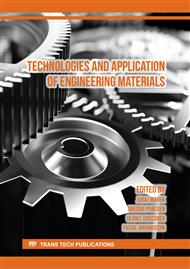[1]
H. Suprayitno and R.A.A. Soemitro, Prelimanery Reflexion on Basic Principle of Infrastructure Asset Management, J. Manaj. Aset Infrastruktur. 2 (2018) 1-9.
DOI: 10.12962/j26151847.v2i1.3763
Google Scholar
[2]
T.Y. Tu, Y.Y. Chen, and C.L. Hwang, Properties of HPC with recycled aggregates, Cem. Concr. Res. 36 (2006) 943-950.
Google Scholar
[3]
A. Gastaldini, M. Hengen, M. Gastaldini, F.D. Amaral, M. Antolini, and T. Coletto, The use of water treatment plant sludge ash as a mineral addition, Constr. Build. Mater. 94 (2015) 513-520.
DOI: 10.1016/j.conbuildmat.2015.07.038
Google Scholar
[4]
J. Bolomey, Granulation et prévision de la résistance probable des bétons, Travaux. 19 (1935) 228-232.
Google Scholar
[5]
T. Powers and T. Brownyard, Studies of the Physical Properties of Hardened Portland Cement Paste, J. Proc. 43 (1946) 101-132.
Google Scholar
[6]
K. Tjokrodimuljo, Concrete Technology, Nafiri Publishers, Yogyakarta, 2007.
Google Scholar
[7]
Sutikno, Concrete Practice Guide, State University of Surabaya, Surabaya, 2003.
Google Scholar
[8]
T. Mulyono, Concrete Technology, Andi Offset, Yogyakarta, 2005.
Google Scholar
[9]
Y. Senhadji, M. Mouli, and H. Khelafi, Sulfate attack of Algerian cement-based material with crushed limestone filler cured at different temperatures, Turkish J. Eng. Environ. Sci. 34 (2010) 131-134.
Google Scholar
[10]
M.N. Triaswati, H. Didik, W. Boedi, and I. Wahyu, Use of Stone Ash to Reduce Natural Sand Aggregate in Concrete Mix with Additive Type D Additive, J. Infrastruct. Facil. Asset Manag. 3 (2019) 35-44.
Google Scholar
[11]
F. Handayani, Benefits of stone ash waste as an additional building material, in VI Annu. Natl. Semin. Civ. Eng. Masters Progr. ULM Banjarmasin (2019) 59–68.
Google Scholar
[12]
O. Onal and A.U. Ozturk, Artificial neural network application on microstructure–compressive strength relationship of cement mortar, Adv. Eng. Softw. 41 (2010) 165-169.
DOI: 10.1016/j.advengsoft.2009.09.004
Google Scholar
[13]
M. Azimi-Pour and H. Eskandari-Naddaf, ANN and GEP prediction for simultaneous effect of nano and micro silica on the compressive and flexural strength of cement mortar, Constr. Build. Mater. 189 (2018) 978-992.
DOI: 10.1016/j.conbuildmat.2018.09.031
Google Scholar
[14]
M.I. Khan, Predicting properties of High Performance Concrete containing composite cementitious materials using Artificial Neural Networks, Autom. Constr. 22 (2011) 516-524.
DOI: 10.1016/j.autcon.2011.11.011
Google Scholar
[15]
B.R. Prasad, H. Eskandari, and B.V. Reddy, Prediction of compressive strength of SCC and HPC with high volume fly ash using ANN, Constr. Build. Mater. 23 (2009) 117-128.
DOI: 10.1016/j.conbuildmat.2008.01.014
Google Scholar
[16]
D.K. Bui, T. Nguyen, J.S. Chou, H. Nguyen-Xuan, and T.D. Ngo, A modified firefly algorithm-artificial neural network expert system for predicting compressive and tensile strength of high-performance concrete, Constr. Build. Mater. 180 (2018) 320-333.
DOI: 10.1016/j.conbuildmat.2018.05.201
Google Scholar
[17]
M.R. Khosravani, S. Nasiri, D. Anders, and K. Weinberg, Prediction of dynamic properties of ultra-high performance concrete by an artificial intelligence approach, Adv. Eng. Softw. 127 (2018) 51-58.
DOI: 10.1016/j.advengsoft.2018.10.002
Google Scholar
[18]
A. Oztas, M. Pala, E. Ozbay, E. Kanca, M. Caglar, and M.A. Bhatti, Predicting the compressive strength and slump of high strength concrete using neural network, Constr. Build. Mater. 20 (2006) 769-775.
DOI: 10.1016/j.conbuildmat.2005.01.054
Google Scholar
[19]
S. Chithra, S.S. Kumar, K. Chinnaraju, and F.A. Ashmita, A comparative study on the compressive strength prediction models for High Performance Concrete containing nano silica and copper slag using regression analysis and Artificial Neural Networks, Constr. Build. Mater. 114 (2016) 528-535.
DOI: 10.1016/j.conbuildmat.2016.03.214
Google Scholar
[20]
M. Abu Yaman, M.A. Elaty, and M. Taman, Predicting the ingredients of self compacting concrete using artificial neural network, Alex. Eng. J. 56 (2017) 523-532.
DOI: 10.1016/j.aej.2017.04.007
Google Scholar
[21]
M. Uysal and H. Tanyildizi, Predicting the core compressive strength of self-compacting concrete (SCC) mixtures with mineral additives using artificial neural network, Constr. Build. Mater. 25 (2011) 4105-4111.
DOI: 10.1016/j.conbuildmat.2010.11.108
Google Scholar
[22]
B. Vakhshouri and S. Nejadi, ANFIS application to predict the compressive strength of lightweight self-compacting concrete, in Proc. 2016 Futur. Technol. Conf. San Francisco, CA, USA, 2016, 28–35.
DOI: 10.1109/ftc.2016.7821586
Google Scholar
[23]
H. Mashhadban, S.S. Kutanaei, and M.A. Sayarinejad, Prediction and modeling of mechanical properties in fiber reinforced self- compacting concrete using particle swarm optimization algorithm and artificial neural network, Constr. Build. Mater. 119 (2016) 277-287.
DOI: 10.1016/j.conbuildmat.2016.05.034
Google Scholar
[24]
A. Sadrmomtazi, J. Sobhani, and M. Mirgozar, Modeling compressive strength of EPS lightweight concrete using regression, neural network and ANFIS, Constr. Build. Mater. 42 (2013) 205-216.
DOI: 10.1016/j.conbuildmat.2013.01.016
Google Scholar
[25]
A.F. Bingol, A. Tortum, and R. Gül, Neural networks analysis of compressive strength of lightweight concrete after high temperatures.Mater, Materials. 52 (2013) 258-264.
DOI: 10.1016/j.matdes.2013.05.022
Google Scholar
[26]
F. Altun, O. Kis i, and K. Aydin, Predicting the compressive strength of steel fiber added lightweight concrete using neural network, Comput. Mater. Sci. 42 (2008) 259-265.
DOI: 10.1016/j.commatsci.2007.07.011
Google Scholar
[27]
A. Hendi, A. Behravan, D. Mostofinejad, S.M. Moshtaghi, and K. Rezayi, Implementing ANN to minimize sewage systems concrete corrosion with glass beads substitution, Constr. Build. Mater. 138 (2017) 441-454.
DOI: 10.1016/j.conbuildmat.2017.02.034
Google Scholar
[28]
O. Hodhod and G.A. Salama, Analysis of sulfate resistance in concrete based on artificial neural networks and USBR4908-modeling, Ain Shams Eng. J. 4 (2013) 651-660.
DOI: 10.1016/j.asej.2013.02.007
Google Scholar
[29]
M. Abambres and E.O. Lantsoght, ANN-Based Fatigue Strength of Concrete under Compression, Materials. 12 (2019) 3787.
DOI: 10.3390/ma12223787
Google Scholar
[30]
P. Duan, Z. Shui, W. Chen, and C. Shen, Effects of metakaolin, silica fume and slag on pore structure, interfacial transition zone and compressive strength of concrete, Constr. Build. Mater. 44 (2013) 1-6.
DOI: 10.1016/j.conbuildmat.2013.02.075
Google Scholar
[31]
F. Deng, Y. He, S. Zhou, Y. Yu, H. Cheng, and X. Wu, Compressive strength prediction of recycled concrete based on deep learning, Constr. Build. Mater. 175 (2018) 562-569.
DOI: 10.1016/j.conbuildmat.2018.04.169
Google Scholar
[32]
National Standard Agency, Procedure for C Light Concrete Mixing with Light Aggregate SNI 03-3449-2002, Jakarta. (2002).
Google Scholar
[33]
SK SNI 03-1974-1990, Concrete Compressive Strength. (1990).
Google Scholar



